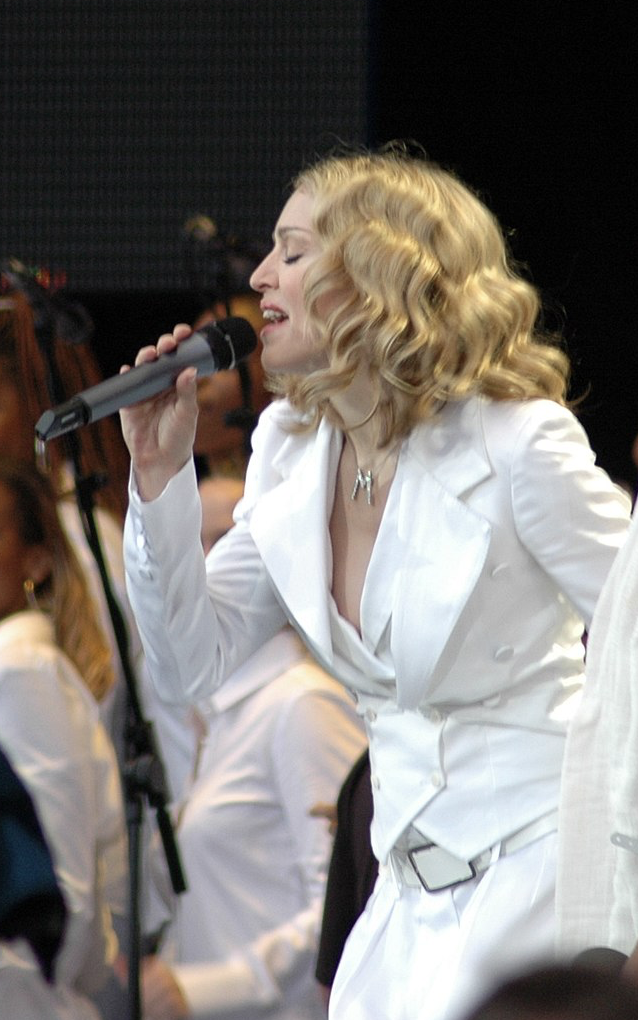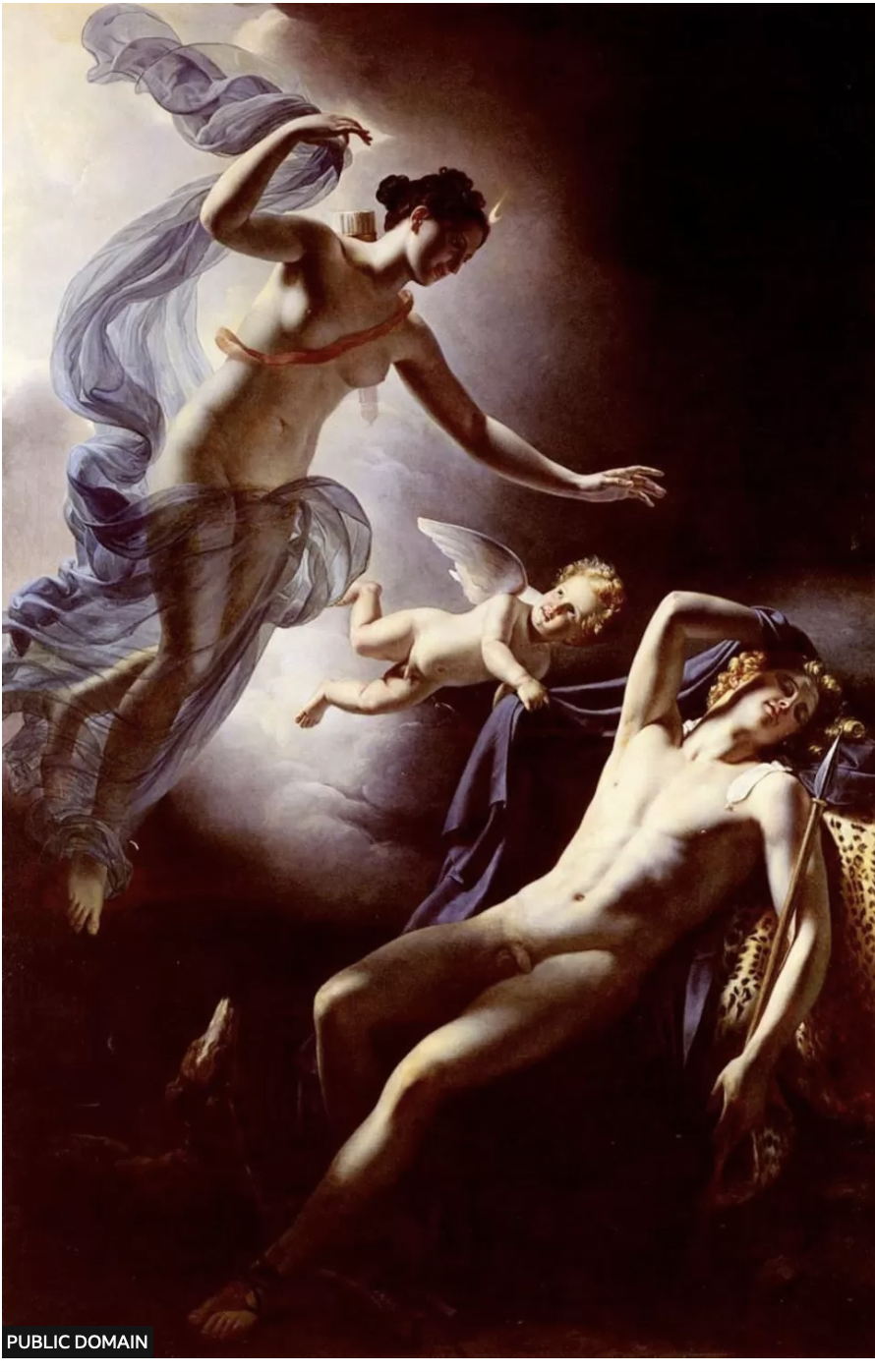
Madonna in concert in 2005. Credit: David Cushing, https://www.flickr.com/
Madonna, singer of “Vogue” fame, has been asked to negotiate a loan of an 1822 Jerome-Martin Langlois painting from her personal art collection. The mayor of Amiens requested that the singer loan the work to the Musée de Picardie in the French city. The painting was purchased by Madonna in 1989 at auction, around the time that the singer’s fourth studio album was released. Decades later, in 2015, a museum curator recognized the painting after Madonna was featured in an issue of the weekly publication Paris Match Magazine. The article included a photograph of the “Material Girl” in her home, with the painting visible in the background.
When the curator examined the subject matter of the painting in the photo – a small Cupid in flight dashing between Roman mythological figures Diana and Endymion – a match was made. The painting looked remarkably similar to a work once owned by the Musée de Picardie and thought to have been destroyed by World War I bombings. Further inquiry revealed that the painting once thought lost is very likely the work hanging in Madonna’s home.
Notably, the city of Amiens has not accused Madonna of any wrongdoing, and it is not demanding the restitution of the work. Rather, the city has requested a loan. Such a deal could be fortuitous for both Madonna and the city of Amiens. Madonna would keep the painting in her private collection following the loan, and Amiens could display the painting in its original glory. Moreover, Amiens would no doubt benefit from the added publicity of a loan from such an A-list celebrity. This would be particularly timely for the city, coincidentally gunning to be named the Cultural Capital of Europe in 2028. (Amiens, among other cities such as Brovmov in the Czech Republic and Skopje in North Macedonia, are on the most recent short list for the recognition).

Diana and Endymion, Jérôme-Martin Langlois, 1822, Credit: Public Domain
Madonna has yet to respond to the loan request. Her decision whether to accept or reject the offer to negotiate might be influenced (hopefully, positively) by certain outcomes of other high-profile celebrities who have faced ownership claims against artwork held in their personal collections.
Other Celebrities With Problematic Art
One path for some has been to return the work outright. As we discussed previously, Nicolas Cage returned a dinosaur skull he bought at auction once it was established that it had been illegally excavated. Another 80s icon, Boy George, was keen to return a contested piece to its claimant owner. In 2011, the stylish singer returned an icon to Cyprus, to later be reinstalled in the Church of St. Charalambos. The church’s bishop saw the icon in the background of a video interview filmed in Boy George’s home. He recognized the piece as one stolen from the church following Turkish invasion in 1974. Boy George’s graciousness in returning the piece is heartening (he went on record as “happy [to see] the icon going back to its original home.”
Another path forward for celebrities with problematic artwork is to negotiate in good faith with the claimants, in lieu of lengthy and costly litigation. Take, for example, a piece put up for auction by the stewards of the late Gianni Versace’s private art collection. In 2010, a painting that once hung in Versace’s Lake Como villa was consigned for auction at Sotheby’s in London. The listing, a portrait by Johann Zoffany entitled Portrait of Major George Maule caught the eyes of the direct descendants of the painting’s owner. The descendants contacted the Art Loss Register, who negotiated with Sotheby’s. After what was reported as an amicable mediation, the piece was pulled from auction. The work was returned to its original owners, who were “overjoyed” to be able to hang the painting from their own walls.

Van Gogh’s Vue de l’Asile et de la Chapelle de Saint-Remy, gracing the catalog cover for the sale of Elizabeth Taylor’s collection (Credit: Christie’s LLC)
Negotiating has also proven to be a feasible and mutually beneficial option for the Andrew Llyod Webber Art Foundation. After the Foundation put up a Picasso for auction at Sotheby’s in London, heirs of a Jewish family claimed that the work was sold under duress to the Nazi Party by their ancestor. In 2010, the parties reached an agreement of undisclosed terms (and, as the painting is valued at over $60 million, a substantial award was likely given to the family). Following the negotiations, the family willingly relinquished all ownership claims of the work, and seemingly walked away content with their end of the bargain.
However, some celebrities – either with the budget for litigation or incredibly personal ties to the contested work at issue (or both) – are willing to fight in court. Elizabeth Taylor is one example. She defended herself in litigation after she was contacted about a piece in her personal art collection in 2004. The 1889 work, a Van Gogh painting entitled View of the Asylum and Chapel at Saint Remy, was sold at auction to the actress at Sotheby’s in London in 1963. Decades later, descendants of a Jewish woman named Margarete Mauthner claimed that the painting was rightfully theirs. They asserted that it had been sold by their ancestor under duress by Nazis. The Orkin family sought redress under the 1998 U.S. Holocaust Victims Act, but was barred from recovery due to the statute of limitations. The 9th Circuit upheld the lower court ruling that the Orkin family had missed their chance to claim ownership, and Elizabeth Taylor kept her painting in her L.A. residence.

Amiens, France. Credit: Library of Congress, Prints and Photographs Collections, licensed via pingnews
Madonna’s Next Steps
Taylor’s unwillingness to relinquish ownership stands in contrast to the negotiations and settlement offers made by Versace and Andrew Llyod Webber’s Art Foundation. The potential for high-profile art buyers to avoid litigation and to instead reach amicable agreements presents a cooperative path forward and an overall more sustainable approach. These types of mediations, which may include the return of the work, give power and voice to claimants, without demonizing buyers who may have been unaware of the work’s problematic provenance. (This is particularly important in the case of celebrity buyers, who often work through intermediaries.) This ensures that justice is served, and that past traumas are recognized, while promoting the preservation and enjoyment of cultural heritage for generations to come.
The humanizing impact of high-profile celebrities who publicly acknowledge original ownership of a problematic work cannot be understated. When celebrities use their platform to give voice to people whose voices have been silenced, they set in motion healing work in the practicum of art and cultural heritage. What will Madonna do, moving forward? Perhaps she will be inspired to accept the loan offer and cooperate amicably with the City of Amiens.
After all, in the agreement put forth by Amiens, Madonna can still “keep her baby.”
.”